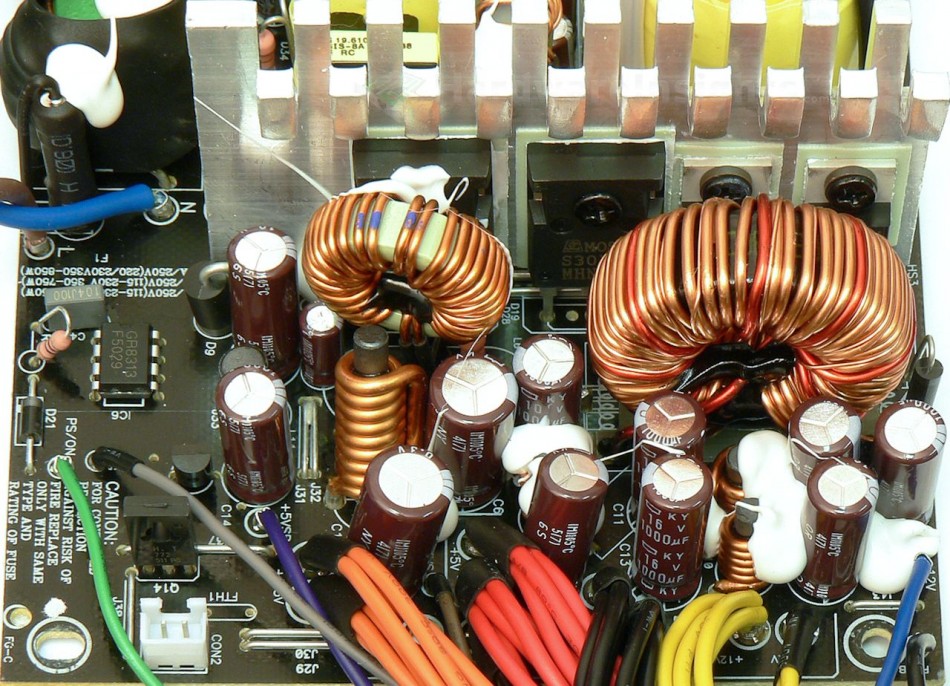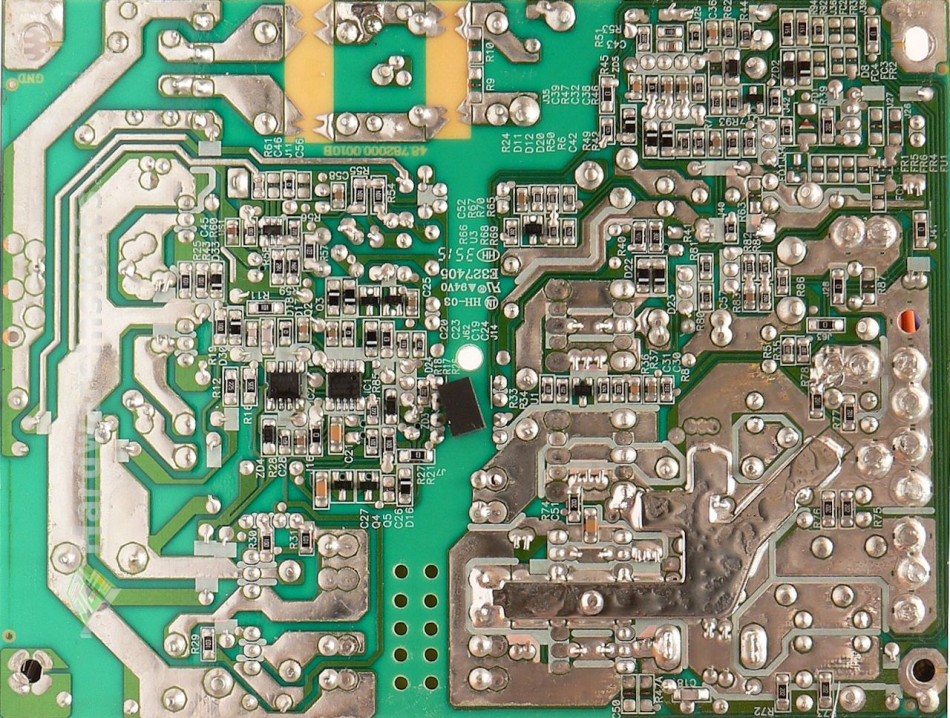Contents
- 1Introduction
- 1.1Packaging and accessories
- 2Connectors & cabling
- 2.1Casing & cooling
- 3Input filtering
- 4Primary side
- 4.1+5 V stand-by rail
- 5Secondary side
- 5.1Build quality
- 6Load testing
- 6.1Loading +5 V SB
- 6.2Voltage hold-up time
- 6.3Combined loading
- 6.4Combined loading ripple
- 6.5Crossloading, overloading
- 6.6Crossloading, overloading ripple
- 6.7Fan speed and temperatures
- 7Conclusion and evaluation
- 7.1Thanks
- 8Addendum - working on the unit
- 8.1Discussion
Secondary side
It’s plainly apparent that this unit uses no DC-DC switchers, as it’s based on an old design with seperate windings for the +5 and +12 V rails, while the +3.3 V rail is derived from the +5 V using a mag amp circuit. The +12 V rail uses three PFC Device Corporation PFR30L60CT schottky rectifiers (30/250 A at 25 °C and 60 V, drop of 0.6 V at 15 A) in a TO-220 package, connected in parallel. This should prove interesting, especially since the unit is supposed to provide 37.5 A on this rail…the remaining rails look better equipped, as they use the TO-247 MOSPEC S30D45C (30/300 A at 125 °C and 45 V, drop of 0.55 V at 25 °C). As for filtration, we have two Chemi-Con KY 1000/16 caps before and after two Pi coil filters for the +12 V, 1+1 KY 1000/10 for the +5 V and a pair of 2200/6.3 for the +3.3 V. The -12 V rail uses a single 1000/16. The inductors seem adequate enough.
The thermistor for the fan speed regulation is glued with silicon to the heatsink. As for the secondary monitoring, we have the 8-pin Grenergy GR8313 secondary monitor, wich obviously monitors only three things: undervoltage, overvoltage and a potential state of a short-circuit. That means the statement in the manual about the over current protection is just a lie. As well, it also provides the Power Good signal and monitors incoming PWR On signal from motherboard. Best-case scenario voltages for when the protection kicks in are 3.7, 5.7 and 13.2 V for overvoltage, and 2.4, 3.7 and 9.5 V for undervoltage. As we shall see however, these figures were wishful thinking at best. As for the modular external connector board, there really is not much to say about it. The wires used to connect to it are 18AWG, and there are some unpopulated spots for some small filtering capacitors. Other than that, it only houses some ordinary PCIe and EPS connectors.
This secondary monitor is even worse than the Weltrend or Silicon Touch monitors we are used to. At such wild theoretical voltages (especially the lower ones in the undervoltage-state scenario) no computer could function in the first place, so what use is this kind of protection when it kicks in ages after the PSU has already dropped way out of ATX spec? And since the only over power “protection” this unit may have is on the primary side – and I am afraid it will be even worse than it sounds, because it might be only implemented as a power limit – I am half expecting some sort of catastrophic failure here. I should say that at least it does indeed have only quality capacitors, I feel that that’s irelevant in the face of units like the Cooler Master G550M platform which doesn’t have the best capacitors, but uses a far superior DC-DC switching design, and also has a full set of fully-working protections, and even OTP.
Build quality
As usual, I’ll focus on the overall build quality and other things like electrical safety here, as the quality of the components that were used was already discussed before. The seperation between the primary and secondary sides is adequate, and we also have some extra holes that were drilled under the main transformer for extra cooling. Both the varistor and the thermistor are insulated with heatshrink, and the same goes for some leads that are in close proximity to other components. There is even a tooth-shaped patter on the PCB under the common-mode chokes, which is most likely for arc suppression during high-voltage spikes. The glue used to hold components before wave-soldering took place is some kind of silicone, and although I’ve seen it applied more liberally before, I can’t exactly say that they were saving it for a rainy day here.
Conductive paths are reinforced by thich layers of solder, and the secondary common ground is even reinforced by a thick metal shunt (probably copper). The soldering itself is not that bad for an inexpensive unit and is actually quite clean come to think of it. Sure there are a couple of small joints here and there that could maybe use some rework, but the unit will still most likely work just fine. I found only two rework bodges, four medium solder balls and a pair of microscopic ones. The overall build quality of this unit seems more or less OK, and I shall deduct only four points here for the Zalman ZM500-GVM…



